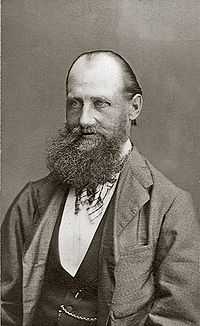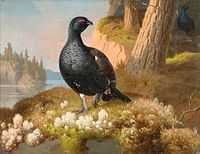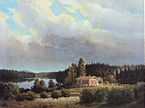Ferdinand von Wright

(date unknown)
Ferdinand Henricsson von Wright (19 March 1822, Haminalahti, near Kuopio - 31 July 1906, Kuopio) was a Swedish-Finnish painter. He is best known for his landscapes and animal paintings, especially his detailed depictions of birds, but he also created still-lifes and portraits.
Biography
His ancestors were Scottish merchants who had settled in Narva during the 17th-Century and his father was a retired Major who owned a large, well-known estate. He was the youngest of nine surviving children and was tutored at home. Two of his older brothers, Magnus and Wilhelm, also became painters and illustrators. Following in their footsteps, he showed an early aptitude for art, developed during time spent hunting and exploring nature while making sketchbooks.
He travelled to Sweden for the first time when he was fifteen, visiting Bohuslän Province with Wilhelm,[1] who was working as an illustrator for the zoologist Bengt Fredrik Fries. The following year, he went by himself to work for the amateur ornithologist, Count Nils Bonde, who had recently subsidized the publication of a multi-volume Svenska Fåglar (Swedish Birds), with illustrations by Magnus and Wilhelm.

After a few months back in Finland, he returned to Sweden where, in 1842, he briefly studied at the Royal Swedish Academy of Arts with the sculptor Johan Niclas Byström. He went home again in 1844, having been in Sweden for almost six years. Five years later, he went to Turku, where he took some additional lessons from Robert Wilhelm Ekman.[1] In 1852, he and his brothers went to Helsinki, where he set up a studio and began painting more detailed scenes, rather than individual animals. Six years later, he took a trip to Dresden, where he spent two months studying with the noted animal painter Johann Siegwald Dahl.[1] He then travelled to Orust with Wilhelm, staying for a year.
In 1863, he built a home near his family's estate, which he named "Lugnet" (serenity or tranquility in Swedish).[2] He lived there for the next twenty years, occasionally spending time with his sisters in Kuopio. In the early 1870s, he had several strokes and was often bedridden,[1] but continued to paint as much as possible. Eventually, he had to move out of the main part of his home and occupy two smaller guest rooms upstairs. He made his last trip in 1881, to Orust, visiting Wilhelm, who was also ill.
His work became more commercial after this and, in 1886, he produced his best-known work The Fighting Capercaillies.[1] He also contributed articles to various ornithological journals. About this time, he received a state artists' pension.[2] Many former students came to visit and, in the late 1890s, the bird painter Matti Karppanen stayed on to be his pupil and assistant. Slowly, he became more withdrawn and died in 1906.
Selected paintings
-

Black Grouse (1864)
-

The Surprise (1880)
-

Black Grouses (1872)
-

View from Lugnet (1877)
References
- ↑ 1.0 1.1 1.2 1.3 1.4 Brief biography @ the University of Jyväskylä website.
- ↑ 2.0 2.1 Brief biography @ Lähteillä.
Further reading
- Anto Leikola, Juhani Lokki and Torsten Stjernberg:
- Von Wright -veljesten linnut (Brothers of the Birds), Otava, 2003, ISBN 951-118-037-1
- Taiteilijaveljekset von Wright: Suomen kauneimmat lintumaalaukset (The Artist Brothers Von Wright, Finland's Most Beautiful Bird Paintings), Otava, 1986, ISBN 951-109-231-6
- Wilhelm & Ferdinand von Wright dagböcker (journals), Svenska litteratursällskapet i Finland, 2008, ISBN 978-951-5831-37-8
External links
| Wikimedia Commons has media related to Ferdinand von Wright. |
| Wikimedia Commons has media related to Svenska Fåglar (illustrations). |
- More paintings and drawings by Ferdinand von Wright @ the Kansallis Galleria
- Von Wright's paintings of mallards, a video @ Kantti.net
- "Cultural Path in the Landscape of the Von Wright Brothers"
|